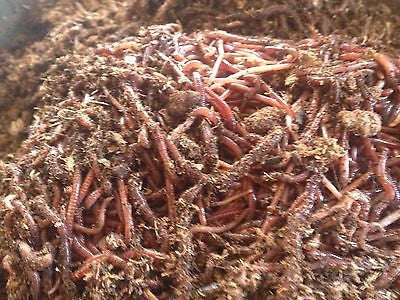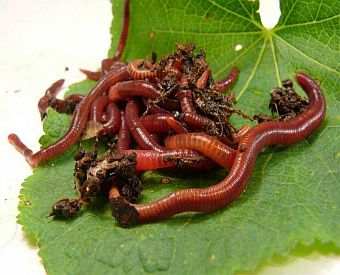Making The Most Of the Benefits of Red Wiggler Worms: A Comprehensive Guidebook for Home Gardeners and Urban Farmers
In the world of lasting horticulture techniques, red wiggler worms stand as unrecognized heroes, quietly changing natural waste into nutrient-rich castings that can function wonders for dirt wellness. By exploring the intricacies of just how to efficiently care for and make the most of the benefits of red wiggler worms, people can open a wealth of chances for improving the sustainability and efficiency of their horticulture undertakings.
Comprehending Red Wiggler Worms
Red Wiggler worms, renowned for their efficient composting capacities, are a species of earthworms widely used in vermiculture techniques. These worms, clinically known as Eisenia fetida, flourish in decomposing organic material, making them perfect prospects for composting.
One key attribute of Red Wiggler worms is their reproductive rate. These hermaphroditic creatures possess both male and women reproductive body organs, permitting them to replicate swiftly under positive problems. A fully grown Red Wiggler can generate numerous spawn in a brief period, making sure a consistent populace within a composting system.

Establishing a Worm Container
When developing a worm bin for vermiculture objectives, correct preparation and focus to detail are necessary for producing a helpful setting for Red Wiggler worms. Begin by selecting an appropriate container for your worm container.

Location the worm bin in a trendy, dark place away from straight sunlight and severe temperatures. Frequently keep track of the dampness degrees, adding water if the bed linens feels flaky or completely dry. Feed the worms a well balanced diet of vegetables and fruit scraps, staying clear of citrus fruits, onions, and spicy foods. By adhering to these actions, you can set up a prospering worm bin that will efficiently process natural waste right into nutrient-rich vermicompost for your yard.
Feeding and Keeping Worms
Guaranteeing a nourishing and well balanced diet plan is essential for the wellness and productivity of Red Wiggler worms in a vermiculture system. Red Wigglers are ravenous eaters, qualified of consuming their own body weight in natural issue daily. To preserve a successful worm population, it is necessary to provide them with a selection of food scraps such as vegetables and fruit peels, coffee premises, tea bags, and crushed eggshells. It is vital to avoid feeding them citrus fruits, onions, garlic, dairy products, meat, and oily foods as these can be dangerous to the worms or create unpleasant odors in the bin.
Proper moisture levels are likewise important for the well-being of Red Wiggler worms. The bed linens should seem like a damp sponge, providing enough dampness for next page the worms to take a breath via their skin. Frequently check the moisture levels and readjust by including water or completely dry bed linen product as needed. Additionally, maintaining proper temperature problems in between 55-77 ° F(13-25 ° C )will certainly make sure ideal worm task and recreation. By diligently monitoring their diet plan, wetness, and environmental conditions, home gardeners and metropolitan farmers can maintain a effective and healthy and balanced Red Wiggler worm populace for composting purposes.
Collecting Worm Castings
To effectively draw out nutrient-rich worm spreadings from the vermicompost, an organized harvesting procedure is important for making best use of the composting advantages. Red Wiggler Worms. The initial step in gathering worm castings is to urge the worms to move to one side of the container. This can be accomplished by placing fresh food scraps on one side and leaving the various other side uninterrupted for a few days. Once the bulk of worms have dodged with fresh food, the castings can be accumulated from the opposite side.
After the castings have been collected, it is necessary to separate any kind of staying worms from the spreadings to avoid harming them throughout storage space or application. One efficient approach is to develop cone-shaped stacks of spreadings under bright light. Worms will intuitively move away from the light, permitting easy separation and elimination.
Last but not least, the harvested worm spreadings need to be kept in an awesome, dark, and dry place to maintain their high quality and efficiency as a nutrient-rich soil modification. By adhering to these actions, home garden enthusiasts and city farmers can make best use of the advantages of red wiggler worms in their vermicomposting systems.
Making Use Of Worm Castings in Horticulture
The unification of nutrient-rich worm spreadings right into yard soil can significantly enhance plant growth and total dirt wellness. Worm spreadings, also understood as vermicast, are an all-natural fertilizer created by red wiggler worms as they damage down raw material. These spreadings are abundant in necessary nutrients like nitrogen, phosphorus, potassium, and beneficial microbes that advertise plant growth and boost soil structure.
When utilizing worm castings in gardening, it is important to mix them completely into the dirt or use them as a top dressing around plants. The slow-release nature of worm spreadings guarantees a constant supply of nutrients to plants in time, reducing the risk of nutrient site leaching and promoting long-term soil fertility. Additionally, worm spreadings help boost dirt aeration, water retention, and microbial task, developing a healthy and balanced atmosphere for plant roots to flourish.

Verdict
In final thought, the use of red wiggler worms in home horticulture and city farming can considerably benefit soil health and wellness and plant growth. By comprehending exactly how to establish up and preserve a worm bin, feed the worms properly, and harvest their nutrient-rich castings, gardeners can take full advantage of the benefits of these earthworms.
In Discover More Here the realm of sustainable gardening techniques, red wiggler worms stand as unhonored heroes, silently changing organic waste into nutrient-rich castings that can function marvels for dirt health and wellness.When establishing a worm bin for vermiculture purposes, correct prep work and interest to information are crucial for developing a helpful atmosphere for Red Wiggler worms. The first step in collecting worm spreadings is to motivate the worms to migrate to one side of the container. Worm spreadings, also known as vermicast, are an all-natural plant food created by red wiggler worms as they break down natural issue. By comprehending how to establish up and preserve a worm bin, feed the worms appropriately, and collect their nutrient-rich castings, garden enthusiasts can make best use of the advantages of these earthworms.